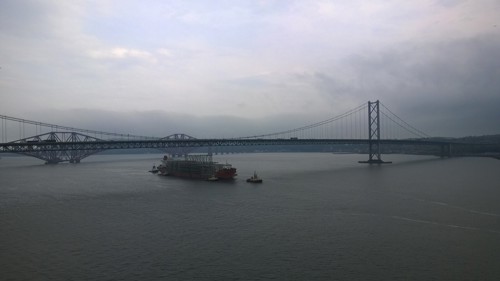West footpath/cycleway is currently closed for essential maintenance, please use the east footpath/cycleway.
Access RestrictionsOn the deck: the amazing scale of the Queensferry Crossing project
23 May 2014This week the first bridge deck sections arrived in Rosyth. On a boat, a really, really big boat! (OK, it’s a ship, a 60,000 dead weight tonnage bulk carrier which is a quarter of a kilometer long to be exact.)
Project management is all about milestones. Yes, they help you measure progress and all that important stuff but, in a more human way, they’re the moment you allow yourself to take a quick breath. To look at how far you’ve come and, armed with that little sense of accomplishment, take another breath and push on for the challenges ahead. The overall Forth Replacement Crossing scheme is replete with milestones: opening the Fife ITS and M9 Junction 1a developments in the winter of 2012/13, completing the Queensferry Crossing tower foundations in the summer of 2013; each pier the approach viaducts reach, each new concrete pour as the towers climb higher above the Forth… and so on.
But among all these impressive and cumulative feats, this week’s milestone felt that little bit special. It’s the moment when the sheer scale of this project became real. Not many of us will ever get to see the towers up close but, for the moment at least, it’s only then that their size really hits home. But when the ship arrived on Monday (May 19) and made its way under the rail and road bridges during evening rush hour, you couldn’t miss the scale. Some of us watched it from North Queensferry, from the Forth Road Bridge in our cars or the east walkway; project staff had their cameras on the roof of the project office. Others had an amazing perch at the top of the Centre Tower …

… or even better from one of the project boats …

The project has rightly been called the biggest Scottish transport infrastructure project for a generation. To borrow a phrase from Ernest Hemingway, however, it’s better to show than to tell. Monday’s dramatic delivery certainly helped with that.
It’s worth remembering the origin of the FRC project. The main cables of the Forth Road Bridge have lost around 10 per cent of their strength, which cannot be restored without replacing entire cables. That would involve prolonged closure and almost unimaginable disruption to one of Scotland’s most important economic arteries. For that and a series of other resilience and maintenance issues, the Scottish Parliament overwhelmingly backed the 2010 Bill (becoming an Act in 2011) authorising the new bridge’s construction. Not only that, but rubber stamping a procurement strategy that had a primary objective to build the bridge and surrounding roads efficiently in five and a half years, before the potential for restrictions to HGVs on the current road bridge in 2017.
More than 30,000 tonnes of steel and 150,000 tonnes of concrete are the major materials required for the Queensferry Crossing and any tender to build the bridge was always going to focus on supply orders that could deliver quantity, quality, speed and resilience. Much of the steel is coming from FCBC’s suppliers in China and Darlington, with suppliers around Scotland providing fabricated steel for permanent and temporary works.
The ZPMC operation on Changxing island, in the Yangtze river opposite Shanghai, is on a scale you’d struggle to find matched across Europe. The plant is 5km long, it employs 28,000 people which is roughly the same as the population of Clydebank or Motherwell. ZPMC claim their 4,000 strong team of welders is the largest in the world. Even more incredibly, even though the Queensferry Crossing will be one of the largest bridges of its type in the world, the steel for its deck is being produced using roughly 5 per cent or lower of the output capacity of the plant.
It is also important to realise that the steel is just a part of the story. Each 250 tonne deck section is tripled in weight by the addition of 500 tonnes of concrete in the assembly sheds on the north shore of the Forth. This operation is a vital part of the process and has led to the creation of around 100 jobs in Rosyth.
Unloading of the ship takes around seven days, so it will soon be returning on the six week journey back to Shanghai. There will be three more shipments of steel arriving in the coming months, three more reminders of the global scale of a world-class bridge.


